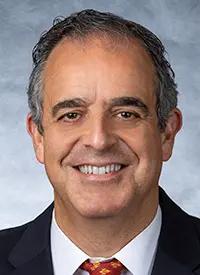Adding Bispecific Antibody to Natural Killer Cells May Be Effective in Heavily Pretreated Lymphoma
Patients with heavily pretreated lymphoma experienced promising clinical responses following treatment with the innate cell engager AMF13 plus preactivated and expanded natural killers (NK) cells.
Yago Nieto, MD, PhD

The addition of the innate cell engager AMF13 to preactivated and expanded natural killer (NK) cells may represent an effective treatment for pretreated patients with advanced lymphoma, according to findings from a phase 1/2 study (NCT04074746) that were presented during the 2022 AACR Annual Meeting. 1
Results showed that patients experienced a median overall response rate (ORR) of 89.5% (n = 17/19). Overall, 10 patients experienced complete responses (CRs) and 7 experienced partial responses (PRs).2
Lead author Yago Nieto, MD, PhD, a professor of medicine in the Department of Stem Cell Transplantation and Cellular Therapy at the University of Texas MD Anderson Cancer Center, in Houston, discussed the findings during a press conference during the meeting. He said the study team was pleasantly surprised by the quality of tumor responses in patients with resistant lymphomas.
“This is the first clinical trial using off the shelf cord blood-derived cytokine-induced memory-like ex vivo expanded NK cells precomplexed with the innate cell engager AMF13 construct to treat patients with CD30-positive relapsed/refractory Hodgkin lymphoma,” he said. “We saw very encouraging activity in this population of very heavily pretreated patients.”
The current standard of care for relapsed CD30-positive lymphomas is brentuximab vedotin (Adcetris), an antibody-drug conjugate that delivers a toxic cytoskeleton destabilizing agent to cells expressing CD30. However, not all these lymphomas respond to brentuximab vedotin. When that treatment fails, those tumors then become extremely resistant to killing and patients are left with very few effective therapeutic options.
To address the problem, investigators enrolled 22 patients with relapsed or refractory CD30+ lymphoma into this single-center phase 1/2 trial, 20 of whom were diagnosed with Hodgkin lymphoma (HL). All had active progressive disease at enrollment, and none received bridging therapy. Patients were heavily pretreated, with a median of 7 (range, 1-14) prior lines of therapy. Nine underwent autologous stem cell transplantation (SCT) and 5 received allogeneic SCT.
Eligible patients had relapsed/refractory CD30-positive classical HL, B-cell non-Hodgkin lymphoma, anaplastic large-cell lymphoma, or peripheral T-cell lymphoma that was refractory or intolerant to brentuximab vedotin. They needed to have an ECOG performance status of 2 or below, and adequate renal, hepatic, pulmonary, and cardiac function.
The median age was 40 years (range, 20-75). Most patients were white (68.2%) and male 68.1%).
Patients receive 2 cycles of fludarabine/cyclophosphamide, followed by AFM13-CB NK cells at 3 dose levels—DL1 (106 NK/gg), DL2 (107 NK/kg), and DL3 (108 NK/kg)—on day 0 plus 3 weekly intravenous infusions of 200 mg AFM13, a CD30/CD16A bispecific antibody. Nineteen patients completed both planned cycles of treatment.
Nieto and colleagues isolated NK cells from cord blood, then used a mixture of cytokines to activate the cells into a memory-like state, making them more persistent and effective. They then expanded the cells in culture and complexed them with AFM13.
At a median follow-up of 11 months, progression-free survival (PFS) and overall survival (OS) rates across all 3 dose levels were 52% and 81%, respectively. Across all dose levels, 53% of patients experienced CR and 37% had PR. Eleven percent had progressive disease.
Expansion of NK cells occurred immediately after infusion and persisted for 3 weeks.
Investigators established DL3 as the recommend phase 2 dose (RP2D). All 13 (100%) patients treated at this dose level responded to therapy, including eight CRs (62%).“Five of those patients were in CR after cycle 1, and 3 additional patients converted from PR to CR after cycle 2,” Nieto added.
The median PFS was 67% and the median OS was 93% in the RP2D population.
Investigators did not record any cytokine release syndrome or graft vs host disease (GVHD), or neurotoxicity. “Our preliminary results show an excellent tolerability profile,” Nieto said.
There was no instance of infusion-related reactions (IRRs) associated with AFM13-NK cells across 40 infusions. There was 1 instance of grade 3 IRR and 4 grade 2 IRRs in 108 infusions of AFM13 alone. Investigators observed no dose limiting toxicities.
“Never before in mankind have we seen this approach, really leading to pretty staggering results,” Timothy Yap, MBBS, PhD, FRCP, a medical oncologist and associate director of translational research in the Institute for Personalized Cancer Therapy at the University of Texas MD Anderson Cancer Center, said. “Everyone can see for themselves how impressive these results are. In addition to that, the actual tolerability profile is truly excellent with no instances of cytokine release syndrome, no neurotoxicity, no GVHD. Truly, truly impressive.”
References
- Nieto Y, Banerjee P, Kaur I, et al. Innate cell engager (ICE) AFM13 combined with preactivated and expanded cord blood (CB)-derived NK cells for patients with refractory/relapsed CD30+ lymphoma. Presented at: 2022 AACR Annual Meeting; April 8-13, 2022; New Orleans, LA. Abstract CTPL01.
- Natural killer cells complexed with a bispecific antibody may provide new treatment option for patients with advanced lymphoma. News release. AACR. Published April 10, 2022. Accessed April 10, 2022.


